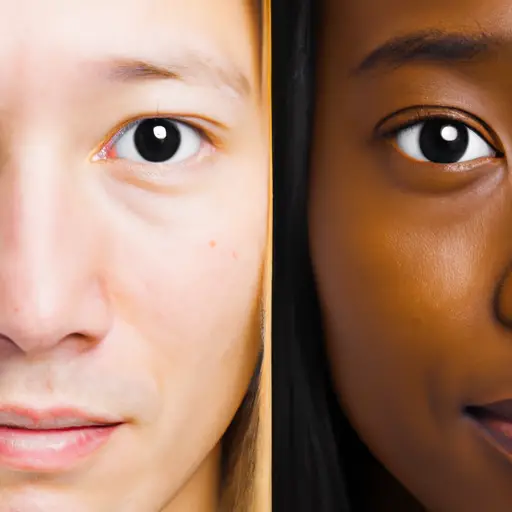So what is the difference between race and ethnicity
1. What is the definition of race?
Race is a social construct that has been used to categorize people based on physical characteristics and ancestry. It is usually associated with skin color, although other features such as facial features, hair texture, and cultural practices may also be taken into account. Race can have political, economic, or social implications depending on the context in which it is used. It has been used throughout history to separate and oppress marginalized communities and to stratify societies according to privilege and power. Despite its contested meaning and implications, race continues to exist today as an important concept in many societies across the world.
2. What is the definition of ethnicity?
Ethnicity is a term that refers to shared cultural heritage. It’s typically used to describe people who identify with a certain group or nation, based on common ancestry, language, history, and traditions. This could include nationalities such as Irish or German; races such as African American or Asian; religions like Judaism or Islam; and even subcultures within these groups. Ethnic identity can also involve shared values and customs that are passed down from generation to generation.
3. Are race and ethnicity mutually exclusive categories?
No, race and ethnicity are not mutually exclusive categories. While many people use the two terms interchangeably, they actually refer to different concepts. Race provides information about a person’s physical traits and is generally determined by their ancestry or heritage. Ethnicity on the other hand is a social construct that usually encompasses language, national identity, shared history, religion and customs among others. Overlap between these two categories can occur when a person identifies with both cultural aspects from their heritage as well as certain physical characteristics associated with it.
4. How have definitions of race changed over time?
The definition of race has changed significantly over time. In the past, race was seen as a strictly biological concept with different races identified based on physical characteristics such as skin color. However, in recent decades, this view has been largely rejected and replaced by a more scientific understanding that acknowledges the complexity of human genetics and the reality that humans are all part of one single species.
Today, many researchers believe that there is no such thing as biologically distinct racial categories among humans because people are too genetically similar for any meaningful distinctions to be made along these lines. Instead, most scientists now agree that what we think of as “race” is actually a social construct created by culture and history which assigns meaning to physical differences between groups of people rather than being rooted in biology or genetics.
5. Is race a biological or social construct?
Race is a complicated concept with many layers, and it can be difficult to define. It is both biological and social in nature. On the biological level, race refers to shared physical characteristics like skin color or hair texture that are determined by genetics. These physical traits are used to group people into distinct categories for the purpose of understanding differences between them.
On a social level, however, race has been used historically as an artificial construct to divide humans into different groups based on political power dynamics and cultural identity rather than biology alone. This means that racial identities often have more to do with social hierarchy than they do with scientific classification. Furthermore, since these distinctions are socially constructed they can vary from region to region and change over time depending on historical context and prevailing attitudes of the day.
6. Does everyone fit neatly into one racial category?
No, not everyone fits neatly into one racial category. In fact, many people identify as being of multiple races or ethnicities. For example, a person may identify as both Hispanic and Caucasian or African American and Native American. Some individuals even go beyond those two categories to include Asian or Pacific Islander ancestry in their identity. This is because race is a social construct rather than an objective set of criteria that can be definitively applied to any individual. Additionally, family histories often contain elements of multiple cultures which further complicates the idea of fitting into one racial category since many people now have mixed backgrounds that cannot be easily classified by traditional definitions of race.
7. How do different cultures define ethnicity differently from each other?
Cultures around the world define ethnicity in a variety of ways. Generally, ethnicity describes a group of people who share similar cultural traits such as language, religion, and history. In some cases however, perceived physical characteristics are also used to identify an ethnic group. For example, in East Asia many ethnicities are defined by physical features such as skin tone or eye shape. Additionally, different cultures may assign varying levels of significance to various distinguishing factors when it comes to defining an ethnicity. For instance, while one culture may emphasize racial identity another culture may place more emphasis on nationality or religious beliefs instead. Ultimately though all definitions have common roots in shared values and customs that distinguish one community from another.
8. In what ways does racism intersect with ethnic identity and vice versa ?
Racism and ethnic identity intersect in a multitude of ways. Racism is the belief that one group is superior to another based on stereotypical characteristics, while ethnicity refers to an individual’s cultural heritage or ancestry. Ethnic identity impacts how individuals are perceived by others through preconceived notions about their race and culture. Conversely, racism can cause individuals from different ethnic backgrounds to be treated differently both socially and politically, even when they share similar cultural traits. For example, individuals from the same racial background may experience different levels of discrimination depending on their accent or dialect due to stereotypes associated with certain groups. This intersection between racism and ethnic identity can have far-reaching implications for people’s lives including physical health outcomes due to unequal access healthcare resources as well as economic disparities caused by systemic racism within employment opportunities. Ultimately, understanding how these two concepts interact with each other helps us better understand the complexity of prejudice in our society today.
9. Do all individuals experience their racial/ethnic identities in the same way ?
No, individuals do not all experience their racial/ethnic identities in the same way. Everyone’s life experiences are unique and different, meaning that they will have varying perspectives when it comes to their racial/ethnic identity. Some may view themselves as a product of their race or ethnicity and embrace its culture, while others may strive to move away from it. Moreover, some people may only be aware of how society perceives them based on their race or ethnicity which could be negative or positive depending on the context. Each individual’s experiences with racism and privilege can also influence how they view themselves in terms of their racial/ethnic identity. There is no one-size-fits-all approach to understanding an individual’s relationship with his or her own identity; each person has his or her own unique set of lived experiences that shape this relationship.
10. How has globalization impacted how people think about, understand, and identify their own race/ethnicity ?
Globalization has drastically impacted how people think about, understand and identify their own race/ethnicity. It has opened up a dialogue between different cultures and identities allowing us to learn from each other’s perspectives on identity and self-expression. People are beginning to challenge the traditional boundaries of race, ethnicity and nationality which have been defined for centuries by those in positions of power. Through this process we can gain an appreciation for our individual backgrounds while also understanding that skin color is not representative of culture or character. Globalization encourages everyone to create their own definition of “racial identity” based upon a variety of experiences they encounter throughout life. This allows individuals to find strength in being unique rather than trying to conform to societal norms regarding race or ethnicity – ultimately leading us all closer together as one unified global community.

